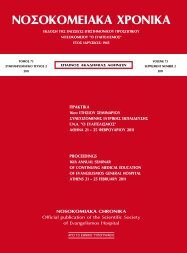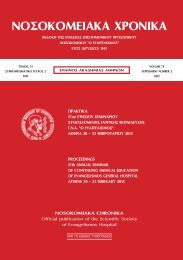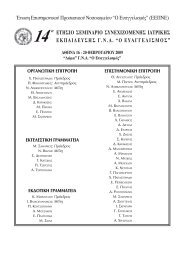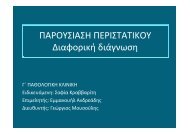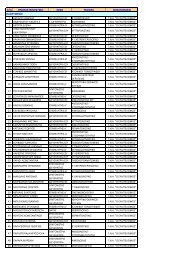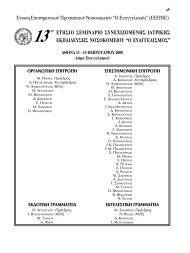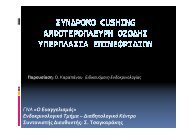ÎÎΣÎÎÎÎÎÎÎÎΠΧΡÎÎÎÎÎ
ÎÎΣÎÎÎÎÎÎÎÎΠΧΡÎÎÎÎÎ
ÎÎΣÎÎÎÎÎÎÎÎΠΧΡÎÎÎÎÎ
You also want an ePaper? Increase the reach of your titles
YUMPU automatically turns print PDFs into web optimized ePapers that Google loves.
ΑΝΑΣΚΟΠΗΣΗΜέτρηση – Παρακολούθηση Επιπέδων Φαρμάκωναπό την φαρμακοκινητική στην φαρμακογενωμικήΑ ΜελπίδουΧημικός, Βιοχημικό Εργαστήριο Γ.Ν.Α. «ο Ευαγγελισμός», European Clinical ChemistSUMMARYMELPIDOU A. Therapeutic Drug Monitoring From pharmacokinetics to pharmacogenomics. The two major sourc−es of interindividual variability in drug response are caused by variation in the relationship between: a) dose and plasmaconcentration (pharmacokinetic variability) and b) drug concentration at the receptor and the response (pharmacody−namic variability). Therapeutic drug monitoring (TDM) is the measurement of the http://en.wikipedia.org/wiki/Medica−tion concentration levels of specific drugs in various biological fluids (serum, whole blood etc). TDM is usefull in theidentification of patient compliance or not, in the individualisation of dosage by maintaining drug concentrations inthe bloodstream within a target range (therapeutic range, therapeutic window) as well as in the evaluation of over−dose or toxicity. Each medication has a pharmacokinetic profile which comprises the following processes: a)Liberation,b)Absorption c)Distribution, d)Metabolism and e)Elimination (LADME). A great list of sources can contribute to thepharmacokinetic variability (age, disease, drug interactions, genetic polymorphisms of drug metabolism etc). There aresome major criteria, described in the text, that should be fulfilled in order for the TDM to be reliable and clinicallyworthwhile. TDM is only of value for a limited number of drugs. The characteristics of drugs which make them suitablefor, or make them require, TDM are: marked pharmacokinetic variability, concentration related therapeutic and adverseeffects, narrow therapeutic index, defined therapeutic (target) concentration range, desired therapeutic effect difficultto monitor, reliable methods of analysis. The correct time of sampling is important for TDM. In general, the specimenshould be drawn after steady state is reached (at least 4 half−lives after a dosage adjustment or initiation of therapy) andjust before the next dose (trough level). The several categories of drugs that require monitoring as well as the variousdrug assay methods are thoroughly discussed in the text. The numerous variables that influence the interpretation ofdrug concentration data are also further specified. Today’s the combination of classical with pharmacogenomical TDMis the base of individualization of therapy. Νοsokomiaka Chronika, 72, 59−74, 2010.Key words: Pharmacokinetic variability, therapeutic range, therapeutic window, LADME, steady−state, trough level,Fluorescence Polarization Immunoassay.ΠΕΡΙΛΗΨΗΟι διατομικές διακυμάνσεις στην φαρμακολογική απόκριση οφείλονται σε μεταβολές στην σχέση μεταξύ α)της δόσηςκαι της συγκέντρωσης του φαρμάκου στο πλάσμα (φαρμακοκινητικές) και β)της συγκέντρωσης του φαρμάκου στονυποδοχέα του και της φαρμακευτικής δράσης (φαρμακοδυναμικές). Η Μέτρηση και Παρακολούθηση των ΕπιπέδωνΦαρμάκων (ΠΕΦ) αφορά τον προσδιορισμό των επιπέδων θεραπευτικών φαρμάκων σε διάφορα βιολογικά υγρά. ΗΠΕΦ είναι χρήσιμη στην εκτίμηση συμμόρφωσης, στην εξατομίκευση της θεραπείας με σκοπό την επίτευξη θεραπευ−τικού εύρους καθώς και στην διάγνωση υπερδοσολογίας ή τοξικότητας. Οι συντελεστές που καθορίζουν την συ−γκέντρωση του φαρμάκου στο αίμα, εκτός από την δόση, είναι οι εξής:α)Απελευθέρωση, β)Απορρόφηση, γ)Κατανομή,δ)Μεταβολισμός, ε)Απέκκριση. Ο συνδυασμός των ανωτέρω συντελεστών αποτελεί το φαρμακοκινητικό profileκάθε φαρμάκου. Διάφοροι φυσιολογικοί, παθολογικοί και φαρμακολογικοί παράγοντες (π.χ. ηλικία, γενετικό προ−φίλ κ.α.) συμβάλλουν στην φαρμακοκινητική διακύμανση. Για να είναι δυνατή και αξιόπιστη η παρακολούθηση τωνεπιπέδων ενός φαρμάκου, δηλαδή για να μπορούν να συσχετισθούν τα επίπεδα του φαρμάκου με την απόκριση,



